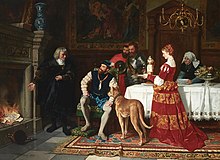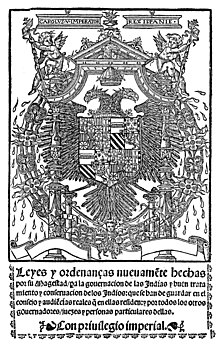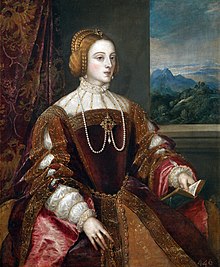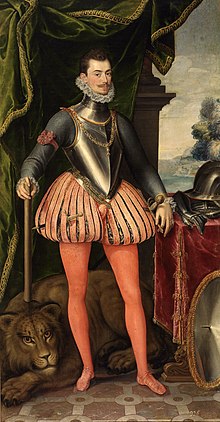Karl V., deutscher Kaiser
Back
Basic data
-
Karl I., König von Spanien Alternative Names
-
February 24, 1500 in Gent
-
†September 21, 1558 in San Jerónimo de Yuste
-
König, Kaiser
-
Spanien, Deutschland, Österreich
Documents
Biographical information from the WeGA
No biographical data found
Biography not available due to one of the following causes:
- Data will be added at a later stage
- Research of the WeGA was without success so far
- It is a well known person where enough information is available online elsewhere, see e.g Wikipedia





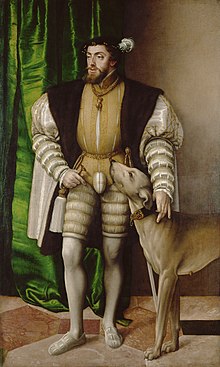

![The Palace of Coudenberg in Brussels from a 17th-century portrait before it burnt down in 1731. Brussels served as the main seat of the imperial court of Charles V in the Low Countries.[54][55] (Source: Wikimedia) The Palace of Coudenberg in Brussels from a 17th-century portrait before it burnt down in 1731. Brussels served as the main seat of the imperial court of Charles V in the Low Countries.[54][55] (Source: Wikimedia)](https://upload.wikimedia.org/wikipedia/commons/thumb/a/a4/Paleis_op_de_Koudenberg.jpg/220px-Paleis_op_de_Koudenberg.jpg)
![Toledo served as the main seat of the Imperial court of Charles V in Castile.[59][60] (Source: Wikimedia) Toledo served as the main seat of the Imperial court of Charles V in Castile.[59][60] (Source: Wikimedia)](https://upload.wikimedia.org/wikipedia/commons/thumb/2/26/Toledo_Skyline_Panorama%2C_Spain_-_Dec_2006.jpg/220px-Toledo_Skyline_Panorama%2C_Spain_-_Dec_2006.jpg)
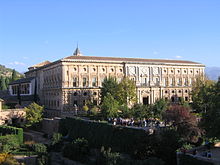



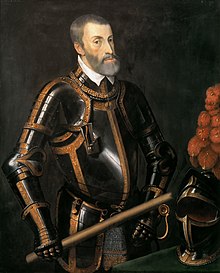


![16th-century perception of German soldiers during Charles's reign (1525) portrayed in the manuscript "Théâtre de tous les peuples et nations de la terre avec leurs habits et ornemens divers, tant anciens que modernes, diligemment depeints au naturel". Painted by Lucas de Heere in the second half of the 16th century. Preserved in the Ghent University Library.[98] (Source: Wikimedia) 16th-century perception of German soldiers during Charles's reign (1525) portrayed in the manuscript "Théâtre de tous les peuples et nations de la terre avec leurs habits et ornemens divers, tant anciens que modernes, diligemment depeints au naturel". Painted by Lucas de Heere in the second half of the 16th century. Preserved in the Ghent University Library.[98] (Source: Wikimedia)](https://upload.wikimedia.org/wikipedia/commons/thumb/2/2e/Archive-ugent-be-79D46426-CC9D-11E3-B56B-4FBAD43445F2_DS-263_%28cropped%29.jpg/220px-Archive-ugent-be-79D46426-CC9D-11E3-B56B-4FBAD43445F2_DS-263_%28cropped%29.jpg)



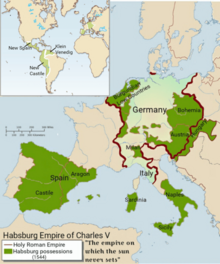
![The second tapestry in the series Battle of Pavia by Bernard van Orley: The Marquis of Pescara leading an Imperial attack on the French cavalry and Georg von Frundsberg leading the Landsknechte against the French artillery[123] (Source: Wikimedia) The second tapestry in the series Battle of Pavia by Bernard van Orley: The Marquis of Pescara leading an Imperial attack on the French cavalry and Georg von Frundsberg leading the Landsknechte against the French artillery[123] (Source: Wikimedia)](https://upload.wikimedia.org/wikipedia/commons/thumb/3/3d/La_batalla_de_Pav%C3%ADa%2C_tapiz_basado_en_una_pintura_de_Bernard_van_Orley.jpg/220px-La_batalla_de_Pav%C3%ADa%2C_tapiz_basado_en_una_pintura_de_Bernard_van_Orley.jpg)

